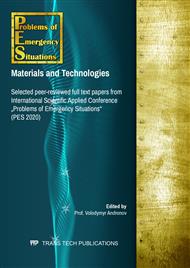[1]
S.M. Shakhov, A.I. Kodryk, O.F. Nikulin, O.M. Titenko, S.A. Vinogradov, I.G. Stylyk Determination of the dependence of compression foam characteristics, Scientific Bulletin of UNFU. 29/5 (2019) 103–106.
DOI: 10.15421/40290520
Google Scholar
[2]
G. N. Abramovich Applied gas dynamics, (1960).
Google Scholar
[3]
Wiebke Drenckman-Andreatta Acoustic characterization of liquid foams with an impedance tube, The European Physical Journal E. (2013).
Google Scholar
[4]
R. Dong-Ho, L. Jang-Won, K. Seonwoong Class B Fire-Extinguishing Performance Evaluation of a Compressed Air Foam System at Differen Air-to-Aqueous Foam Solution Mixing Ratios, Applied Science. 6/191 (2016) 2–12.
DOI: 10.3390/app6070191
Google Scholar
[5]
G. Crampton, A. Kim Сomprasion of the Fire Suppression Performance of Compressed-Air Foam with Air Aspirated and Unexpanded Foam Water Sopution, Research Report. 147 (2007) 1–25.
Google Scholar
[6]
X. Wang, Y. Liao, l. Lin Experimental study on fire extinguishing with a newly prepared multi-component compressed air foam, Chinese Science Bulletin. 54/3 (2009) 492–496.
DOI: 10.1007/s11434-008-0571-3
Google Scholar
[7]
C. Jing-Yuan, X. Mao. Experimental Research of Integrated Compressed Air Foam System of Fixed (ICAF) for Liquid Fuel, Procedia Engineering. 71 (2014), 44–56.
DOI: 10.1016/j.proeng.2014.04.007
Google Scholar
[8]
A. Kamlyuk, O. Navrotskiy, A. Grachulin Tusheniya pozharov penogeneriryuschimi sistemami so szhatyim vozduhom, Vestnik Universiteta grazhdanskoy zaschityi MChS Belarusi. 1/1 (2017) 44-53.
Google Scholar
[9]
V. D. Fadyaev Primenenie kompressionnoy penyi v nasosno-rukavnyih sistemah pri tushenii pozharov elektrooborudovaniya pod napryazhenim, Dis. kandidata teh. nauk: 05.26.03, (2017).
Google Scholar
[10]
L. William, J. San. Properties of compressed air foam, County Fire District, (2001).
Google Scholar
[11]
С. Grady, R. Lafferty How high can you pump wildland firefighting foam, Foam applications for wildland and urban fire management, (2005).
Google Scholar
[12]
D. Feng Analysis on Influencing Factors of the Gas-liquid Mixing Effect of Compressed Air Foam Systems, Procedia Engineering, 52 (2013) 105–111.
DOI: 10.1016/j.proeng.2013.02.113
Google Scholar
[13]
P. Dhrupad Experimental study of pressure drop an bubble size in a laboratory scale compressed air foam generation system, 2017, 135 s.
Google Scholar
[14]
Yu.A. Abramov, V. Rosoha, E. Shapovalova Modeling of processes in fire barrels, 2001, 195 s.
Google Scholar
[15]
A. Semko, M. Beskrovnaya, S. Vinogradov, I. Hritsina, N. Yagudina The usage of high speed impulse liquid jets for putting out gas blowouts, Journal of Theoretical and Applied Mechanics, 3 (2014) 655–664.
Google Scholar
[16]
J. Mawhinney, G. Back Handbook of fire protection engineering, SFPE Handbook of fire protection engineering, 2016, 645 s.
DOI: 10.1007/978-1-4939-2565-0_46
Google Scholar
[17]
L. G. Lojciansky Fluid and Gas Mechanics, (1950).
Google Scholar


